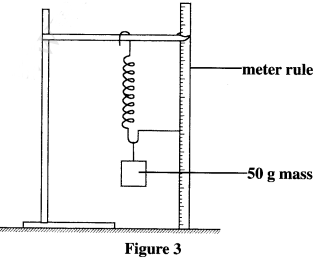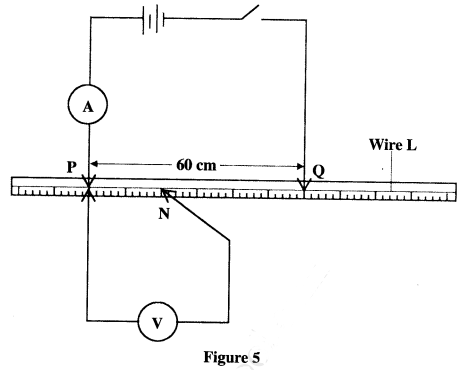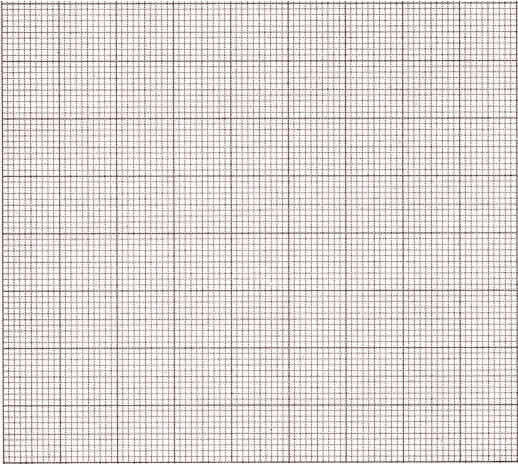Question one
You are provided with the following:
- A micrometer screw gauge(to be shared)
- A vernier caliper (to be shared)
- Glass tube
- A wire labeled M
- Some sellotape
- One 50 g mass
- Some masses (totaling 40 g)
- A meter rule
- 100 ml beaker
- A stand boss and clamp
- A stop watch
- A source of light
- A screen
- Some water
- A measuring cylinder
PART A
Proceed as follows:
- Using a micrometer screw gauge, measure and record the diameter of the wire labeled M. (1 mark)
d = ........ mm
d = ........ m - Using wire M, make a spring as follows:
- Use some sellotape to fix one end of the wire M (about 2.5 cm) along the glass tube;
- Hold firmly the part of the wire under the tape with one hand. Use the other hand to wind 30 turns as closely and tightly as possible. (see figure 1)

- Remove the sellotape and release the spring from the tube.
(The spring will slightly unwind and some turns will disappear)
Bend free ends as shown in figure 2.
- Using a vernier calipers, measure and record the external diameter D of the spring. (1 mark)
D =...........cm.
D = ...........m. - Suspend the spring and a 50 g mass from a retort flask as shown in figure 3.

Count and record the number of turns N of the suspended spring. (1 mark)
N = ……………. - Add 40 g to the 50 g mass and record the extension X of the spring due to the 40 g. (1 mark)
X = ………………cm
X = ………………m - Determine c given that; (1 mark)

- Determine n given that (2 marks)

- With the spring still loaded with 90 g, pull the lower mass slightly downwards and let go so that the mass oscillates vertically. Record the time t for 20 oscillations.
Hence determine the period T.
t = ...........(s) (1 mark)
T = .......... (s) (1 mark) - Determine Z given that

Where m is the mass in kg on the spring. (2 marks)
PART B
Proceed as follows: - Place the 100 ml beaker on a meter rule and pour 80 cm3 of water into it. Arrange a lamp (source of light) and a screen on either side of the beaker. (see figure 4)

- Adjust the position of the lamp on the meter rule so that its centre is a distance u = 12 cm from the beaker. Switch on the light. Adjust the position of the screen until a well focused vertical line (the image of filament ) is formed on the screen. Measure and record in table 1 the image distance V between the screen and the beaker.
- Repeat part (I) for other values of u shown in table 1 and complete the table.
Distance u (cm) 12 16 20 Distance V (cm) 
Table 1 - Determine m, the mean value of y using the values in table 1. (1 mark)
m=…………………… -
- With the meter rule outside the beaker, measure the height h of the water meniscus above the bench. (1 mark)
h =…………….. cm - Determine the value of P given that. (1 mark)

- Hence determine the value of f given that
 to one decimal place. (2 marks)
to one decimal place. (2 marks)
- With the meter rule outside the beaker, measure the height h of the water meniscus above the bench. (1 mark)
Question two
You are provided with the following:
- An ammeter
- A voltmeter
- Two cells (size D)
- A cell holder
- A switch
- A wire labeled L mounted on a millimetre scale
- A micrometer screw gauge (to be shared)
- Six connecting wires at least four with crocodile clips
Proceed as follows:
- Using a micrometer screw gauge, measure and record the diameter d of the wire L. (1 mark)
d = ..... mm
d = ..... m - Place the two cells in series in the cell holder and use the voltmeter to measure the total electromotive force (emf) E0 of the battery. (1 mark)
E0 = ..... V. - Starting with the switch open, connect the circuit as shown in figure 5. P and Q are points on the wire L such that PQ is 60 cm. (PQ should remain 60 cm throughout the experiment.)
N is a point on the wire such that PN is 10 cm (0.1m)
-
- Close the switch and record the current I.
I = ……………A (1 mark) - Measure and record in table 2 the potential difference across PN.
- Measure and record the potential difference across PN for the other values of PN shown in table 2 and complete the table. (The current is expected to remain constant)
Hint: The switch should be closed only when reading the voltmeter.
Table 2
(6 marks)Length PN(m) 0.1 0.2 0.3 0.4 0.5 0.6 p.d(V) Resistance (V/I) Ω
- Close the switch and record the current I.
- On the grid provided, plot a graph resistance (y-axis) against length. (3 marks)

- From the graph determine:
- The slope S and its units. (3 marks)
- The constant k and its units given that (3 marks)

- Determine constant t given that

Where Vn is the p.d at PN = 0.6m. (2 marks)
QUESTION ONE
PART A
- d = 0.35 ± 0.02 mm (1 mark)
d = 0.00035 m
(3.5 + 0.2) X 10-4 m
- D = 0.75 + 0.05 cm
0.80 + 0.02 cm (1 mark)
D = (8.0 + 0.2) * 10-3 m - N = 26 ± 1 turns (1 mark)
- X = 3.0 ± 0.2 cm (1 mark)
X = (3.0 † 0.2) X 10-2 m - c = 0.4
x
0.4
0.03
13.00 ± 2 Nm-1 (1 mark) - n = c8ND3
d4
13.33 x 8 x 26 x (8.0 x 10-3)3
(3.5 x 10-4)4
= (9.2 +0.2) x 10-10 Nm-2 (2 marks) - t = 9.85s ± 1.00(1 mark)
T = 0.44s (1 mark) - Z = 4π2m
T2
Z = 18.00 ± 2 (2 marks).
PART B
(4 marks)Distance U cm 12 16 20 Distance V cm 5.2 4.8 4.5 Constant y= uv
u + v3.6 3.7 3.7 - m = y1 + y2 + y3 ≈ 3.7
3 (1 mark) -
- h = 5.0 + 0.1 cm
- P = 2.2 + 0.1 cm
- f = 1.30 ± 0.03
QUESTION TWO
- d = 3.0 ± 0.1 x 10-4 m (1 mark)
3.0 + 0.1 x 10-1 mm - E0 = 3.1 ± 0.1V (1 mark)
- 1 = 0.35 ± 0.05 A (1 mark)
Table 1
(4 marks)Length RN (m) 0.1 0.2 0.3 0.4 0.5 0.6 P.d (V) 0.45 0.80 1.20 1.60 1.90 2.25 Resistance ( V )(Ω)
l1.3 2.3 3.4 4.6 5.4 6.4 - Plotting of points 2
Axis labelled with units 1
Scale suitability 1
Straight line 1
5 marks -
- Slope = ΔR
Δl
correct intervals (1 mark)
= 3.4 - 1.3
0.3-0.1
= 2.1
0.2
S = 10.5 ± 0.2 Ωm-1 (1 mark)
correct unit (1 mark)
- S= 4K
πd2
k = πd2 s
4
= π x (3.0 x 10-4)2 x 10.5
4
= 74.22 x 10-8
= 7.422 ± 0.2 x 10-7 Ωm
OR
= 7.422 ± 0.2 x 10-4 22 Ωm
correct evaluation (1 mark)
correct value (1 mark)
- Slope = ΔR
- t = E0 - Vn
1
= 3.0 - 2.25
0.35
2.0 + 0.5 Ω
correct evaluation (1 mark)
correct value (1 mark)
ignore unit
Join our whatsapp group for latest updates
Tap Here to Download for 50/-
Get on WhatsApp for 50/-
Download KCSE 2015 Physics Paper 3 with Marking Scheme.
Tap Here to Download for 50/-
Get on WhatsApp for 50/-
Why download?
- ✔ To read offline at any time.
- ✔ To Print at your convenience
- ✔ Share Easily with Friends / Students

